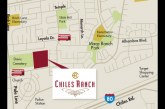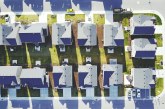The subplots of this discussion were perhaps more interesting that the actual discussion itself on the 610 unit housing development that would also include some retail and perhaps a church or nursing home or another public building. The project is within the city limits, so it is not subjected to a Measure J vote, but it would have to obtain a zoning change.
The council majority felt that with the housing element steering committee being just appointed to update the housing element, it would be premature for the council to approve this project. In fact, as Mayor Ruth Asmundson suggested–the processing of this application would undermine the 15 member steering committee.
The first point of contention was the suggestion by the council majority and the staff report about building a development project again on the Covell Village site. The real motivation for wanting to put on hold this project was thus to see if the housing element process would recommend new development projects for the Covell Village Site. As we pointed out on Tuesday, the 15 member committee is loaded with supporters of the Covell Village development project.
Councilmember Lamar Heystek was clearly perturbed by this suggestion. He pointed out that the Covell Village development project was not just rejected but overwhelmingly rejected by the voters and that this was not something that occurred in the distant past, but was a fairly recent vote and he considered this conversation to be a slap in the face to the will of the voters.
“November 2005 is not in our distant memory. I think it would be disingenuous to assume something for the North Central area. I think as a body, we are kind of tone-deaf.”
Some of this discussion seemed to rankle Councilmember Don Saylor who at one point bizarrely suggested that he was being disrespected. (We’ll have a full video clip of this discussion later on).
In addition to the problems with the insinuation that Covell Village could end up being developed once again, Mayor Sue Greenwald’s concern was that the property was zoned for high-tech industry and she did not want to change that zoning.
The developer admitted under questioning from Mayor Greenwald that he had assumed that he could get the zoning change.
“Every time we’ve said yes to changing zoning to residential, it raises the speculative value of the land and developers will not build high-tech. My personal point of view is, we zoned this high-tech/industrial, and we should keep it that way.”
Later on the Mayor pointed out to me that the city’s designated growth rate of 1.25% per year does not seem like a tremendous amount until you realize exactly what that growth rate means. It means a development project the size of Cannery Park every two years, the size of Wild House every three years, and the size of Mace Ranch every seven years. If you project that out, you realize that is tremendous growth. Growth for which we lack resources such as water and infrastructure to be able to absorb.
—Doug Paul Davis reporting






From the dais,Concilman Saylor publicly argued that the rejected Covell Village site was historically infill which had its designation changed in 1987 by a council 3-2 vote. My recollection is that the designation was changed from urban-reserve to agriculture and that it was never within the city limits, the definition of infill. Is this just being uninformed or playing fast and loose with the facts? deja-vu, all over again?
From the dais,Concilman Saylor publicly argued that the rejected Covell Village site was historically infill which had its designation changed in 1987 by a council 3-2 vote. My recollection is that the designation was changed from urban-reserve to agriculture and that it was never within the city limits, the definition of infill. Is this just being uninformed or playing fast and loose with the facts? deja-vu, all over again?
From the dais,Concilman Saylor publicly argued that the rejected Covell Village site was historically infill which had its designation changed in 1987 by a council 3-2 vote. My recollection is that the designation was changed from urban-reserve to agriculture and that it was never within the city limits, the definition of infill. Is this just being uninformed or playing fast and loose with the facts? deja-vu, all over again?
From the dais,Concilman Saylor publicly argued that the rejected Covell Village site was historically infill which had its designation changed in 1987 by a council 3-2 vote. My recollection is that the designation was changed from urban-reserve to agriculture and that it was never within the city limits, the definition of infill. Is this just being uninformed or playing fast and loose with the facts? deja-vu, all over again?
The 1987 General Plan designated the CV site for incorporation and development, same as it did Shasta, North Star, Wildhorse and Evergreen. CV remained in the plans until the 2001 update, when the Wagstaff council reversed the 1987 decision.
Insofar as the CV site has urban development on three sides, it is infill. However, it is, as you say, outside of our current city boundaries.
The 1987 General Plan designated the CV site for incorporation and development, same as it did Shasta, North Star, Wildhorse and Evergreen. CV remained in the plans until the 2001 update, when the Wagstaff council reversed the 1987 decision.
Insofar as the CV site has urban development on three sides, it is infill. However, it is, as you say, outside of our current city boundaries.
The 1987 General Plan designated the CV site for incorporation and development, same as it did Shasta, North Star, Wildhorse and Evergreen. CV remained in the plans until the 2001 update, when the Wagstaff council reversed the 1987 decision.
Insofar as the CV site has urban development on three sides, it is infill. However, it is, as you say, outside of our current city boundaries.
The 1987 General Plan designated the CV site for incorporation and development, same as it did Shasta, North Star, Wildhorse and Evergreen. CV remained in the plans until the 2001 update, when the Wagstaff council reversed the 1987 decision.
Insofar as the CV site has urban development on three sides, it is infill. However, it is, as you say, outside of our current city boundaries.
Rich Rifkin..Isn’t your “alternative” description of those sites the official urban-reserve designation and aren’t you choosing a definition of infill that is different from the
one that is used by the city?
Rich Rifkin..Isn’t your “alternative” description of those sites the official urban-reserve designation and aren’t you choosing a definition of infill that is different from the
one that is used by the city?
Rich Rifkin..Isn’t your “alternative” description of those sites the official urban-reserve designation and aren’t you choosing a definition of infill that is different from the
one that is used by the city?
Rich Rifkin..Isn’t your “alternative” description of those sites the official urban-reserve designation and aren’t you choosing a definition of infill that is different from the
one that is used by the city?
My recollection of the background for the change from urban-reserve to agriculture was that it was an attempt to put some check on the skyrocketing speculative land value of this property. Changing the designation from urban-reserve to agriculture had no real effect on its availability for development as was clearly demonstrated by the CV project that we just rejected 15 months ago.
My recollection of the background for the change from urban-reserve to agriculture was that it was an attempt to put some check on the skyrocketing speculative land value of this property. Changing the designation from urban-reserve to agriculture had no real effect on its availability for development as was clearly demonstrated by the CV project that we just rejected 15 months ago.
My recollection of the background for the change from urban-reserve to agriculture was that it was an attempt to put some check on the skyrocketing speculative land value of this property. Changing the designation from urban-reserve to agriculture had no real effect on its availability for development as was clearly demonstrated by the CV project that we just rejected 15 months ago.
My recollection of the background for the change from urban-reserve to agriculture was that it was an attempt to put some check on the skyrocketing speculative land value of this property. Changing the designation from urban-reserve to agriculture had no real effect on its availability for development as was clearly demonstrated by the CV project that we just rejected 15 months ago.
Part of the argument to change the zoning of the CV site was that the city had already reached its targeted population growth without the development, schools were overcrowded, infrastructure reaching its limits, etc.
Part of the argument to change the zoning of the CV site was that the city had already reached its targeted population growth without the development, schools were overcrowded, infrastructure reaching its limits, etc.
Part of the argument to change the zoning of the CV site was that the city had already reached its targeted population growth without the development, schools were overcrowded, infrastructure reaching its limits, etc.
Part of the argument to change the zoning of the CV site was that the city had already reached its targeted population growth without the development, schools were overcrowded, infrastructure reaching its limits, etc.